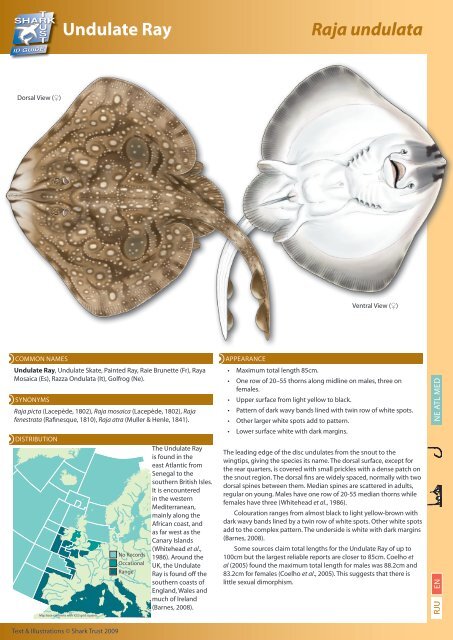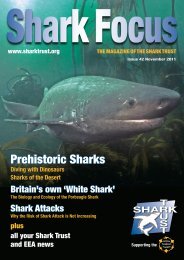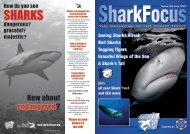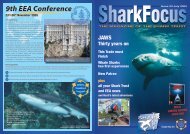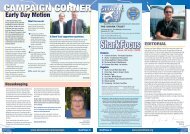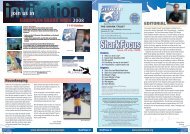Undulate Ray Raja undulata - The Shark Trust
Undulate Ray Raja undulata - The Shark Trust
Undulate Ray Raja undulata - The Shark Trust
Create successful ePaper yourself
Turn your PDF publications into a flip-book with our unique Google optimized e-Paper software.
Dorsal View (♀)<br />
COMMON NAMES<br />
<strong>Undulate</strong> <strong>Ray</strong> <strong>Raja</strong> <strong>undulata</strong><br />
<strong>Undulate</strong> <strong>Ray</strong>, <strong>Undulate</strong> Skate, Painted <strong>Ray</strong>, Raie Brunette (Fr), <strong>Ray</strong>a<br />
Mosaica (Es), Razza Ondulata (It), Golfrog (Ne).<br />
SYNONYMS<br />
<strong>Raja</strong> picta (Lacepède, 1802), <strong>Raja</strong> mosaica (Lacepède, 1802), <strong>Raja</strong><br />
fenestrata (Rafinesque, 1810), <strong>Raja</strong> atra (Muller & Henle, 1841).<br />
DISTRIBUTION<br />
Map base conforms with ICES grid squares.<br />
Text & Illustrations © <strong>Shark</strong> <strong>Trust</strong> 2009<br />
No Records<br />
Occasional<br />
Range<br />
<strong>The</strong> <strong>Undulate</strong> <strong>Ray</strong><br />
is found in the<br />
east Atlantic from<br />
Senegal to the<br />
southern British Isles.<br />
It is encountered<br />
in the western<br />
Mediterranean,<br />
mainly along the<br />
African coast, and<br />
as far west as the<br />
Canary Islands<br />
(Whitehead et al.,<br />
1986). Around the<br />
UK, the <strong>Undulate</strong><br />
<strong>Ray</strong> is found off the<br />
southern coasts of<br />
England, Wales and<br />
much of Ireland<br />
(Barnes, 2008).<br />
APPEARANCE<br />
• Maximum total length 85cm.<br />
• One row of 20–55 thorns along midline on males, three on<br />
females.<br />
• Upper surface from light yellow to black.<br />
• Pattern of dark wavy bands lined with twin row of white spots.<br />
• Other larger white spots add to pattern.<br />
• Lower surface white with dark margins.<br />
Ventral View (♀)<br />
<strong>The</strong> leading edge of the disc undulates from the snout to the<br />
wingtips, giving the species its name. <strong>The</strong> dorsal surface, except for<br />
the rear quarters, is covered with small prickles with a dense patch on<br />
the snout region. <strong>The</strong> dorsal fins are widely spaced, normally with two<br />
dorsal spines between them. Median spines are scattered in adults,<br />
regular on young. Males have one row of 20-55 median thorns while<br />
females have three (Whitehead et al., 1986).<br />
Colouration ranges from almost black to light yellow-brown with<br />
dark wavy bands lined by a twin row of white spots. Other white spots<br />
add to the complex pattern. <strong>The</strong> underside is white with dark margins<br />
(Barnes, 2008).<br />
Some sources claim total lengths for the <strong>Undulate</strong> <strong>Ray</strong> of up to<br />
100cm but the largest reliable reports are closer to 85cm. Coelho et<br />
al (2005) found the maximum total length for males was 88.2cm and<br />
83.2cm for females (Coelho et al., 2005). This suggests that there is<br />
little sexual dimorphism.<br />
RJU EN<br />
NE ATL MED
SIMILAR SPECIES<br />
Leucoraja naevus, Cuckoo <strong>Ray</strong><br />
<strong>Raja</strong> brachyura, Blonde <strong>Ray</strong><br />
<strong>Raja</strong> microocellata, Small-eyed <strong>Ray</strong><br />
<strong>Raja</strong> miraletus, Brown <strong>Ray</strong> (not illustrated)<br />
<strong>Raja</strong> montagui, Spotted <strong>Ray</strong><br />
<strong>Raja</strong> radula, Rough <strong>Ray</strong> (not illustrated)<br />
Leucoraja naevus,<br />
Cuckoo <strong>Ray</strong><br />
<strong>Raja</strong> microocellata,<br />
Small-eyed <strong>Ray</strong><br />
(Not to scale)<br />
Supported by:<br />
Text & Illustrations © <strong>Shark</strong> <strong>Trust</strong> 2009<br />
<strong>Undulate</strong> <strong>Ray</strong><br />
<strong>Raja</strong> <strong>undulata</strong>,<br />
<strong>Undulate</strong> <strong>Ray</strong><br />
<strong>Raja</strong> brachyura,<br />
Blonde <strong>Ray</strong><br />
<strong>Raja</strong> montagui,<br />
Spotted <strong>Ray</strong>
TEETH<br />
<strong>Undulate</strong> <strong>Ray</strong> <strong>Raja</strong> <strong>undulata</strong><br />
<strong>The</strong>re are 40-50 rows of teeth in<br />
the upper jaw. <strong>The</strong> inner series are<br />
wedge-shaped, the middle series<br />
are pointed and the outer series are<br />
chisel-edged (Clark, 1926).<br />
ECOLOGY & BIOLOGY<br />
HABITAT<br />
<strong>The</strong> <strong>Undulate</strong> <strong>Ray</strong> is a bottom dwelling species found on continental<br />
shelves, most commonly on sandy substrates (Barnes, 2008). Studies<br />
from the Portuguese continental shelf show that the <strong>Undulate</strong><br />
<strong>Ray</strong> is most common from 10-30m (33–100ft) with the number of<br />
individuals caught decreasing rapidly with depth (Coelho et al.,<br />
2005). <strong>The</strong> maximum depth the species has been recorded at is<br />
~200m (655ft), whilst in UK waters it has been found at depths of up<br />
to 72m (235ft) (Moura et al., 2008; Ellis et al., 2004).<br />
DIET<br />
<strong>The</strong> <strong>Undulate</strong> <strong>Ray</strong> has a varied diet depending on sex, maturity<br />
stage and season. When young, it has a fairly generalised diet<br />
consisting of crustaceans, molluscs and small fish. When mature, it<br />
becomes more specialised and feeds almost entirely on crustaceans.<br />
In southern Portugal, the vast majority (up to 79.5% by mass) of the<br />
diet of the <strong>Undulate</strong> <strong>Ray</strong> is Polybius henslowi, a small, pelagic crab.<br />
This is unusual among rajids, many of which show a change in diet<br />
from predominantly small crustaceans to bony fish as they mature<br />
(Moura et al., 2008).<br />
REPRODUCTION<br />
Female <strong>Undulate</strong> <strong>Ray</strong>s mature around 75cm in length when around<br />
9 years old, males mature slightly smaller at ~73cm when around<br />
7½ years old. In common with most elasmobranchs, it matures<br />
relatively late in its life cycle as its maximum estimated age is just<br />
over 20 years (Coelho et al., 2005).<br />
<strong>The</strong> <strong>Undulate</strong> <strong>Ray</strong> is oviparous, meaning that it lays eggs that<br />
then develop outside the parent until ready to hatch. It breeds<br />
seasonally between March and June and its eggcases are commonly<br />
found on beaches across the south coast of England (Moura et al.,<br />
2008; <strong>Shark</strong> <strong>Trust</strong>, 2008). <strong>The</strong>se eggcases are 70–90mm long and 45–<br />
60mm wide when wet with very long horns on each corner. <strong>The</strong>se<br />
horns are distinctive in that they curve inwards at the end and have<br />
thin and curly tips. When washed up on beaches however, these<br />
tips are sometimes not present (<strong>Shark</strong> <strong>Trust</strong>, 2008). In 1997, a female<br />
<strong>Undulate</strong> <strong>Ray</strong> in the Benalmádena Sea Life Centre in Spain started<br />
laying 25 days after mating and continued for 77 days, during which<br />
time she laid 88 eggs. <strong>The</strong> incubation period before the first skate<br />
hatched was 91 days and it measured 14cm in length (De la Rosa,<br />
1998). It is not known if this is typical for wild populations.<br />
Text & Illustrations © <strong>Shark</strong> <strong>Trust</strong> 2009<br />
EGGCASE<br />
1. 70–90mm in length (excluding horns).<br />
2. 45–60mm in width.<br />
3. No keels (<strong>Shark</strong> <strong>Trust</strong>, 2008).<br />
Similar eggcase to the Spotted <strong>Ray</strong>, <strong>Raja</strong> montagui.
Supported by:<br />
COMMERCIAL IMPORTANCE<br />
Historically a commercially important fish, the <strong>Undulate</strong> <strong>Ray</strong> was<br />
taken as bycatch in multispecies trawl fisheries across much of its<br />
range, particularly in the south (Gibson et al., 2006). In southern<br />
Portugal, it can constitute more than 40% of all elasmobranchs<br />
caught in trammel net fisheries and is often taken on longlines<br />
(Coelho et al., 2005).<br />
THREATS, CONSERVATION, LEGISLATION<br />
<strong>The</strong> status of the <strong>Undulate</strong> <strong>Ray</strong> in Europe is uncertain. It is<br />
potentially vulnerable to exploitation because, as with most<br />
elasmobranchs, it matures relatively late and produces few young.<br />
As a result, juvenile and immature specimens are vulnerable to<br />
fishing mortality before they have had a chance to breed (Gibson<br />
et al., 2006). It is targeted across much of its range by trawl and<br />
trammel nets, as well as occasionally being caught by long-line<br />
fishing techniques. In some areas, it also constitutes a substantial<br />
portion of fisheries by-catch. In southern Portugal, it represents<br />
more than 40% of all elasmobranchs caught in trammel nets<br />
(Coelho et al., 2005).<br />
<strong>The</strong> <strong>Undulate</strong> <strong>Ray</strong> is also considered a game fish and is caught<br />
by recreational anglers, though the majority of these are returned<br />
alive and stand a good chance of surviving (Catchpole et al., 2007).<br />
Data from areas where the <strong>Undulate</strong> <strong>Ray</strong> was locally common has<br />
suggested serious declines due to fishing pressure. In Tralee Bay,<br />
southwest Ireland, populations have declined by 60-80% since 1981<br />
and it has been absent in English Channel surveys in recent years<br />
(Gibson et al., 2006).<br />
In 2007, the <strong>Undulate</strong> <strong>Ray</strong> was included on the UK Biodiversity<br />
Action Plan (BAP) list. Though this does not provide any legal<br />
protection for the species in itself, it includes provisions to work<br />
towards European conservation legislation. Its main targets<br />
included plans to stabilise populations in refuge areas and to<br />
facilitate the migration of animals from refuge populations to areas<br />
where they are scarce or extinct.<br />
In 2009 the <strong>Undulate</strong> <strong>Ray</strong> received full protection from the<br />
European Council in ICES areas VIa-b, VIIa-k, VIII and IX, meaning that<br />
it cannot be retained or landed if caught. As elasmobranchs have no<br />
swim bladder that can overinflate or rupture, they are more likely<br />
to survive capture and release than teleost fish (DEFRA, 2008). <strong>The</strong><br />
mandatory release order is therefore likely to significantly reduce<br />
the level of fishing mortality.<br />
Text & Illustrations © <strong>Shark</strong> <strong>Trust</strong> 2009<br />
IUCN RED LIST ASSESSMENT<br />
Endangered (2008).<br />
HANDLING AND THORN ARRANGEMENT<br />
• Handle with care.<br />
• Strong row of midline thorns.<br />
• Thorns present between dorsal fins.<br />
<strong>Undulate</strong> <strong>Ray</strong>
REFERENCES<br />
<strong>Undulate</strong> <strong>Ray</strong> <strong>Raja</strong> <strong>undulata</strong><br />
AGUSTIN, L. Q. 2009. <strong>Raja</strong> <strong>undulata</strong>. <strong>Undulate</strong> <strong>Ray</strong>. Fishbase. www.<br />
fishbase.org.<br />
BARNES, M. K. S. 2008. <strong>Raja</strong> <strong>undulata</strong>. <strong>Undulate</strong> ray. Marine Life<br />
Information Network: Biology and Sensitivity Key Information<br />
Sub-programme [on-line]. Plymouth: Marine Biological<br />
Association of the United Kingdom. www.marlin.ac.uk.<br />
CATCHPOLE, T. L., ENEVER, R., DORAN, S. 2007. Programme 21:<br />
Bristol Channel <strong>Ray</strong> Survival. CEFAS. Lowestoft, UK.<br />
COELHO, R., ERZINI, K., BENTES, L., CORREIA, C., LINO, P. G.,<br />
MONTEIRO, P., RIBEIRO, J., GONÇALVES, J. M. S. 2005. Semipelagic<br />
Longline and Trammel Net Elasmobranch Catches<br />
in Southern Portugal: Catch Composition, Catch Rates and<br />
Discards. Journal of Northwest Atlantic Fishery Science, Vol. 35:<br />
531–537.<br />
DE LA ROSA, J. P. 1998. Painted <strong>Ray</strong>, <strong>Raja</strong> <strong>undulata</strong>, Reproduction.<br />
Florida Museum of Natural History. www.flmnh.ufl.edu/fish/.<br />
DEFRA. 2008. Impact Assessment of Tope <strong>Shark</strong> Protection<br />
Measures. www.defra.gov.uk.<br />
ELLIS, J. R., CRUZ-MARTÍNEZ, A., RACKHAM, B. D., ROGERS, S. I.<br />
2004. <strong>The</strong> Distribution of Chondrichthyan Fishes around the<br />
British Isles and Implications for Conservation. Journal of<br />
Northwest Atlantic Fishery Science, Vol. 35: 195–213.<br />
GIBSON, C., VALENTI, S. V., FOWLER, S. L., FORDHAM, S. V. 2006. <strong>The</strong><br />
Conservation Status of Northeast Atlantic Chondrichthyans;<br />
Report of the IUCN <strong>Shark</strong> Specialist Group Northeast Atlantic<br />
Regional Red List Workshop. VIII + 76pp. IUCN SSC <strong>Shark</strong><br />
Specialist Group.<br />
MOURA, T., FIGUEIREDO, I., FARIAS, I., SERRA-PEREIRA, B., NEVES, A.,<br />
DE FÁTIMA, M., SERRANO GORDO, B., SERRANO GORDO, L. 2008.<br />
Ontogenetic dietary shift and feeding strategy of <strong>Raja</strong> <strong>undulata</strong><br />
Lacepède, 1802 (Chondrichthyes: Rajidae) on the Portuguese<br />
continental shelf. Scientia Marina, 72 (2): 311-318.<br />
SHARK TRUST. 2008. <strong>Undulate</strong> <strong>Ray</strong> – <strong>Raja</strong> undulate. www.eggcase.<br />
org.<br />
WHITEHEAD, P. J. P., BAUCHOT, M. L., HUREAU, J. C., NIELSEN, J.,<br />
TORTONESE, E. (Eds.). 1986. Fishes of the Northeast Atlantic and<br />
Mediterranean. UNESCO. Paris, France.<br />
Text & Illustrations © <strong>Shark</strong> <strong>Trust</strong> 2009<br />
Text: Richard Hurst.<br />
Illustrations: Marc Dando.<br />
Citation<br />
<strong>Shark</strong> <strong>Trust</strong>; 2009. An Illustrated Compendium of <strong>Shark</strong>s, Skates, <strong>Ray</strong>s<br />
and Chimaera. Chapter 1: <strong>The</strong> British Isles. Part 1: Skates and <strong>Ray</strong>s.<br />
Any ammendments or corrections, please contact:<br />
<strong>The</strong> <strong>Shark</strong> <strong>Trust</strong><br />
4 Creykes Court, <strong>The</strong> Millfields<br />
Plymouth, Devon PL1 3JB<br />
Tel: 01752 672008/672020<br />
Email: enquiries@sharktrust.org<br />
For more ID materials visit www.sharktrust.org/ID.<br />
Registered Company No. 3396164.<br />
Registered Charity No. 1064185


